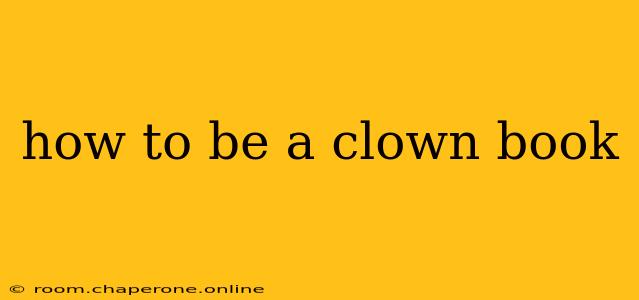So, you want to be a clown? That's fantastic! Whether you dream of bringing laughter to children's parties, captivating audiences in a big top, or simply injecting more silliness into your everyday life, this guide will equip you with the skills and knowledge to master the art of clowning. This isn't just about slapping on a red nose; it's about understanding the craft, honing your performance, and connecting with your audience on a truly emotional level.
Understanding the Clown Persona: More Than Just a Funny Face
The first step in becoming a successful clown is understanding the diverse world of clown characters. There's no one-size-fits-all approach. Different types of clowns cater to different audiences and styles:
Auguste vs. Whiteface: Defining the Classics
-
Auguste: This is the classic "silly" clown, known for their exaggerated movements, slapstick comedy, and often chaotic behavior. Think oversized shoes, mismatched clothing, and a general air of playful mayhem. Their humor relies on physical comedy and often involves pratfalls and unexpected events.
-
Whiteface: This is a more refined clown character, often characterized by a meticulously painted white face, elegant attire, and a more subtle comedic style. They often employ more sophisticated techniques, such as mime, juggling, and witty banter. Their humor is often more intellectual and observational.
Beyond the Basics: Exploring Other Clown Archetypes
Beyond Auguste and Whiteface, there’s a vast spectrum of clown characters waiting to be explored. You might consider developing a character based on:
-
Character Clowns: These clowns build their act around a specific persona, like a grumpy old man, a lovesick teenager, or a mischievous animal. This allows for a greater depth of character development and more nuanced comedic performances.
-
Modern Clowns: Contemporary clowning often blends traditional techniques with more avant-garde styles, incorporating elements of physical theater, storytelling, and even social commentary.
Developing Your Clown Skills: Practice Makes Perfect
Becoming a proficient clown requires dedication and consistent practice. Here are some key areas to focus on:
Mastering the Physicality: Movement and Gesture
-
Exaggeration: Clowning is all about taking everyday movements and exaggerating them to hilarious effect. Practice walking, running, falling, and even simple gestures like waving or pointing with exaggerated movements.
-
Mime: Learn the basics of mime to enhance your physical storytelling abilities. Mime can be used to create hilarious scenarios and add depth to your performance.
-
Balance and Coordination: Many clown routines involve impressive feats of physical comedy that require balance, coordination, and agility. Practice regularly to build these skills.
Honing Your Comedic Timing: The Art of the Pause
-
Observational Humor: Pay close attention to the world around you. Often, the funniest things are the everyday absurdities that we tend to overlook.
-
Improvisation: Learn to improvise and think on your feet. This will allow you to adapt to unexpected situations and engage your audience more effectively.
-
Timing: The success of any joke, especially physical comedy, hinges on perfect timing. Practice pausing at the right moment to maximize the impact of your gags.
Crafting Your Act: From Concept to Performance
Once you've developed your skills, it's time to craft a compelling clown act. Consider these aspects:
Developing a Theme or Storyline: Give Your Act Focus
A cohesive theme or storyline can significantly elevate your performance. Whether it's a day at the circus, a trip to the grocery store, or a whimsical journey through a fantastical land, having a framework allows for more creative freedom and comedic potential.
Selecting Your Props and Costume: Enhance Your Character
Your costume and props should reflect your chosen character and contribute to the overall comedic effect. Don't be afraid to experiment with oversized items, unusual accessories, and unexpected elements.
Rehearsing and Refining: Polish Your Performance
Rehearse your act repeatedly until it feels natural and polished. Pay attention to your timing, your pacing, and your interaction with your audience. Seek feedback from others to identify areas for improvement.
Connecting with Your Audience: The Heart of Clowning
Remember, the most important element of being a clown is connecting with your audience. Bring your heart to every performance. Authenticity and genuine joy are infectious. Let your enthusiasm shine through, and most importantly, have fun! The laughter you create will be the most rewarding part of your journey as a clown.

